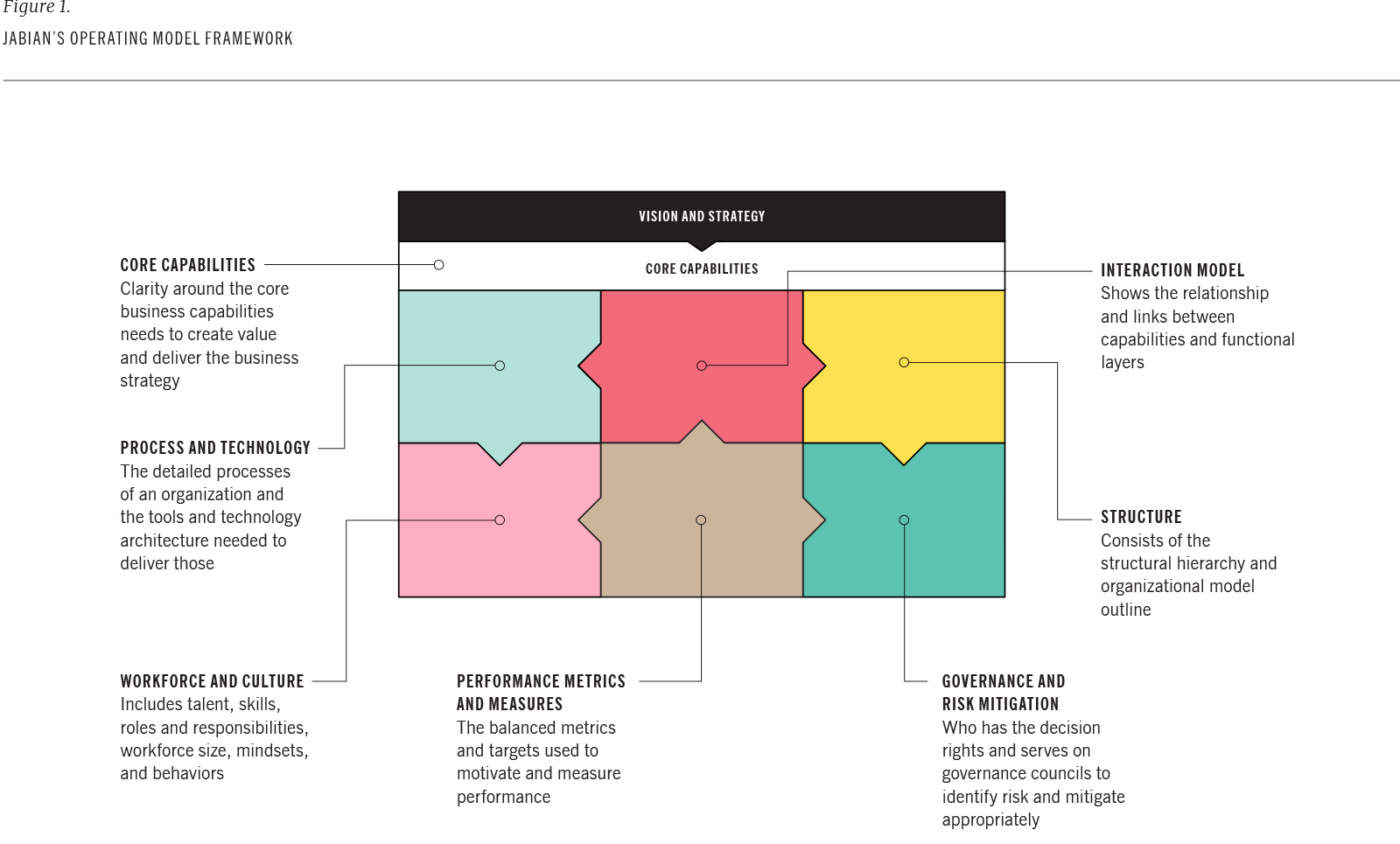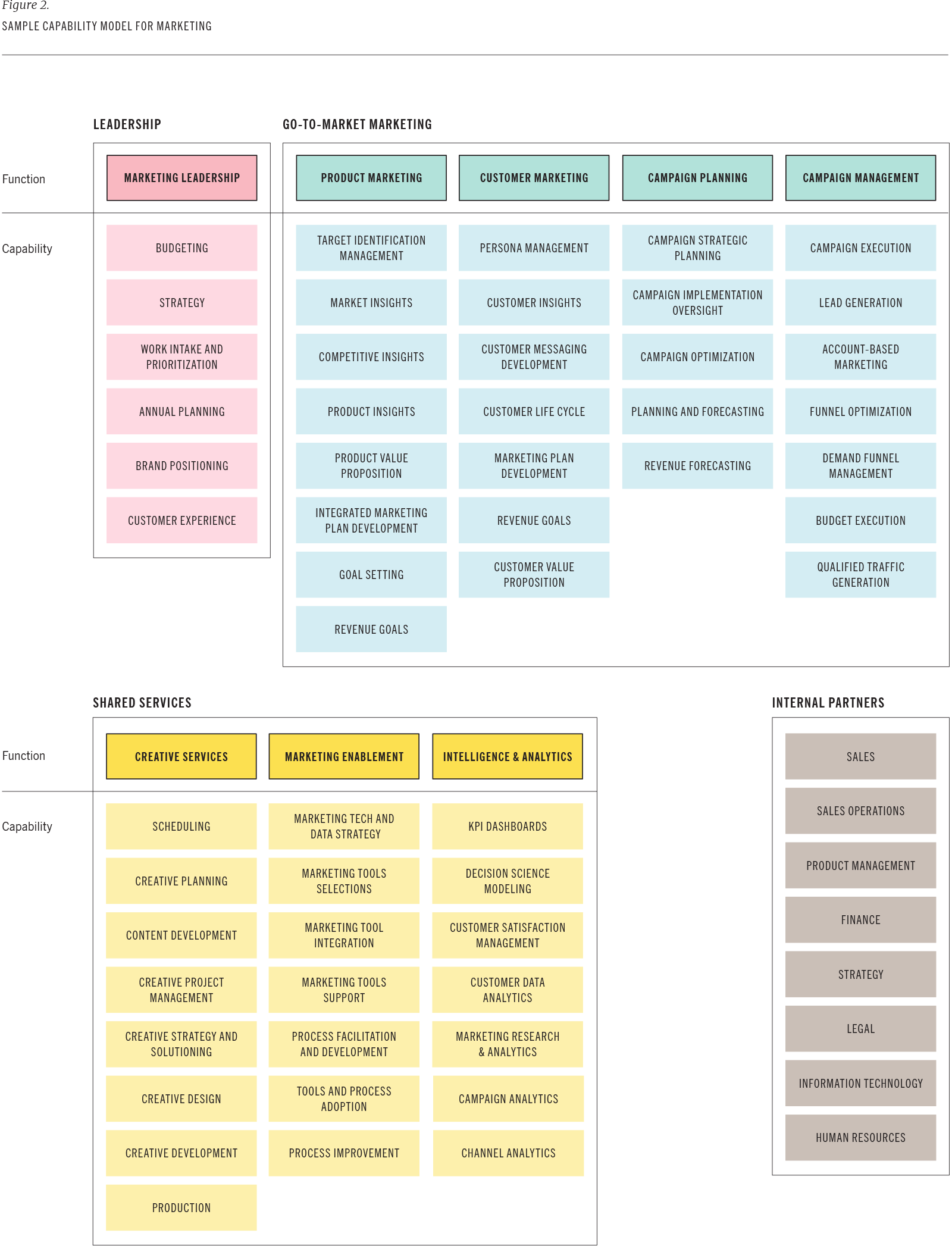The pandemic pushed the world into new ways of working. In the case of the Jabian operating model design and development approach, this turned out to be a good thing. We were able to improve the initial steps of our process for the better because of the widespread use of online meeting and screen-sharing tools.
The rapid adoption of this technology, combined with the capability modeling and interaction design process improvements we made, allowed for a real-time collaborative creation process with our clients, compressed delivery times, and improved buy-in to the new designs. With this evolution of our process, we facilitated stakeholders through capability and interaction modeling in focused online working sessions. This deep stakeholder involvement helped stakeholders feel these changes were not being “done to them,” but rather that they were a part of the process, and they bought in on the output because they helped create it.
When offices started closing in March 2020, we suddenly lost access to many of the key tools and ways of working that were hallmarks of our process, such as the ability to meet in person and collaboratively fill giant whiteboards with new ideas and ways of approaching work; to print, distribute, and easily mark up our favorite 11″x17″-sized Excel and PowerPoint visuals; and to pop by our clients’ offices with quick questions to test our thinking. All of that was gone.
Our new process had to be different; no more whiteboards, no more paper, no more face-to-face in-person meetings. We needed to find a new way to engage our clients and build the necessary deliverables in a virtual environment. Today, our clients are more involved in the process, resulting in an aligned operating model and corresponding organization structure that everyone supports because we built the solution together. Next, we’ll outline and explain our new process.
Operating Model 1.0
Before we do so, let’s take a look at our pre-pandemic model. For years, our original process was broken into five steps:
1.
Conduct Interviews
We conducted interviews to understand our client’s current-state operating model well enough to document it.
2.
Assess the Current State
We assessed how well the current state was working and iterated on that with a small “core team” of clients assigned to lead the effort.
3.
Draft an Improved Operating Model
Based on the assessment of our client’s current state, we independently drafted a future state operating model as influenced by the direction of the industry and known pain points.
4.
Review the New Design
In the review with the core team, we took their feedback and incorporated it into our draft, continued to iterate until everyone was happy, and then took it to leadership for more feedback and iteration.
5.
Gain Support
Finally, the hard part: garnering the change management required to get buy-in, commitment, and engagement from everyone outside of the small core team. That could mean initiating engagement with a dozen or more key executives and other stakeholders who weren’t designated part of the core team, stakeholders who (rightly) suspected someone might be about to encroach on their turf.
Operating Model Approach 2.0:
A More Collaborative Approach
For the record, the core components that make up our operating model framework didn’t change, but how we developed them did. While our original method was effective, the pandemic prohibited us from using our “normal” technique for creating the deliverables. We had to be more creative since we couldn’t all meet live in front of one whiteboard. The result was a more collaborative approach. It also gave us the time to challenge existing ways of working and develop even better processes and structures.
Some elements remain consistent. To improve an operating model, an organization must be willing to “break” the norms of how work gets done today. Have you ever thought about how you might organize the flow of work or an organization structure differently if you had a chance to do so from scratch? Consider this your opportunity. We did.
Some elements changed. For example, by facilitating sessions real-time in Microsoft Teams, we could move boxes around on capability models in a way to test out logical groupings based on complexity, degree of interaction, and similarity of tasks and skillsets required to perform the capability. Here’s how the new process works:
1.
Confirm Mission, Vision, and Goals, and Build the Capability Model (a.k.a. “What does our organization do?”)
As with any operating model effort, we ensure the mission, vision, and goals of the organization are clear and adopted by senior leadership. If that step hasn’t been completed, it’s important to stop and do so before designing the wrong go-forward vision. The next step is building the capability model for the organization. This involves identifying the capabilities needed to achieve the organization’s goals. We then group those capabilities into broader business functions.
In this step, it is important to stay focused on the process and stay away from organizational structure/ownership of the processes. In order to build as pure of a process-focused capability model as possible, we keep the focus on aligning the capabilities to the business functions where they best fit. An initial draft of the capability model takes only a short time to develop, but this foundational activity results in a significant amount of organizational learning and leadership alignment.
What’s different?
Capability modeling lends itself well to support from an online meeting and screen-sharing tool like Microsoft Teams. We used Microsoft PowerPoint to develop the model, on the fly, with our client stakeholders in joint 60- to 90-minute working sessions. One senior strategic advisor facilitated the conversation while a process consultant drove the PowerPoint and manipulated the labeled boxes representing the process-focused capabilities live on everyone’s screens. It proved to be better than whiteboarding as it was clear, clean, and easy to keep current. The ability to have key stakeholders from multiple business functions participating from multiple locations (often across the globe) allowed for deep discussions about where specific capabilities fit within the business.
2.
“THE ABILITY TO HAVE KEY STAKEHOLDERS FROM MULTIPLE BUSINESS FUNCTIONS PARTICIPATING FROM MULTIPLE LOCATIONS (OFTEN ACROSS THE GLOBE) ALLOWED FOR DEEP DISCUSSIONS ABOUT WHERE SPECIFIC CAPABILITIES FIT WITHIN THE BUSINESS.”
3.
Create a List of Key Accountabilities
Once the interactions are complete, all the “gives” for a particular function can be rolled up across all of the interactions with other functions to create a solid list of key accountabilities. For example, creative services shown above will have a clear list of accountabilities based on what that function “gives” to other functions in the organization.
What’s different?
It all really flows from the way we develop the interactions between functions. We develop the interactions with the team members that will do the work in the new model. Defining the gives and gets between their function and all the other functions defined in the capability model breaks a complex question (what all is your function responsible for?) into manageable chunks. Instead of us telling them what they should provide to other functions, they generate it themselves. Of course, when we have best practices or new ideas to offer that our clients don’t come up with, we suggest letting the client decide whether to include them. Almost always, a suggestion we make results in a “yes, that’s a great idea, we need to be doing that, so please add that to the list.” Those interactions become the accountabilities, which in turn feed organization design and detailed role descriptions.
One of the biggest risks in an operating model effort is generating support for the newly defined model. Many operating model design efforts fail because key stakeholders never buy into the new version, mostly because they didn’t have any input in it. The beauty of this process is that most of the change management buy-in is complete once the interactions are defined, at least for the leaders and subject matter experts participating in each business function. Because they developed the capability model and interactions, the subject matter experts involved are already aligned around the to-be model. It’s relatively easy to get the rest of the organization on board with those constituents invested.
Conclusion
This new way of developing capability and interaction models is an engaging and cost-effective way to launch a new operating model effort within any organization. The learning that happens across the organization, along with the resolution of sometimes long-standing friction points between functions, is invaluable. These operating model foundational components can then serve as the basis for detailed process design, organization design, technology implementation, governance process, and cultural transformation. It’s worth asking again: If you could design how work happens within your organization or broader company from a clean slate, would it look the same as it does today? Would you get the same results?



